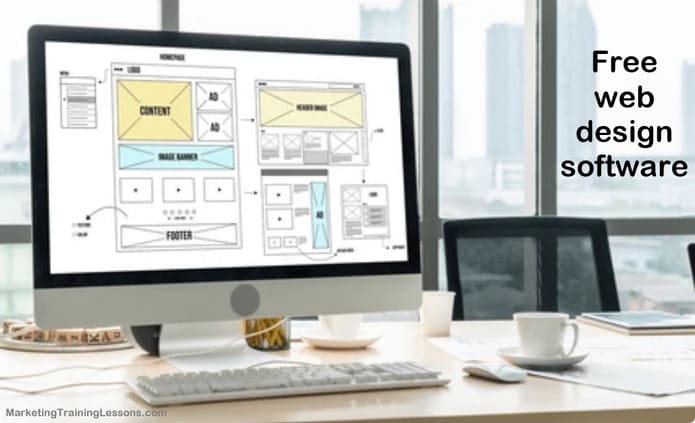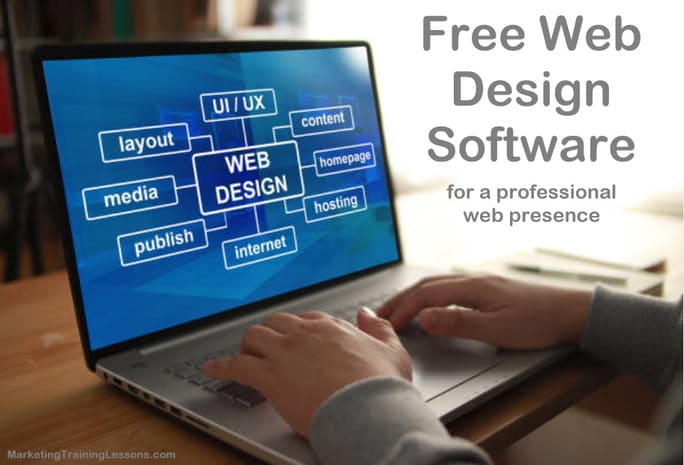Free Web Design Software For A Professional Web Presence
About Free Web Design Software

Honestly, searching for reliable free web design software as a beginner—it’s kind of a minefield.
There’s no shortage of so-called “solutions,” from ultra-simple drag-and-drop builders to code editors that might as well speak another language. It’s enough to make your head spin.
Over the years, I’ve tested my fair share of these tools (probably too many, if we’re being honest). I can tell you which options actually deliver results and won’t waste your time.
Whether you’re building a branded company website or just getting your ideas out there, trust me—there are solid, cost-free resources out there that can help you kick things off the right way.
Click here for my #1 recommendation for making money online while working from home
Why You Should Consider Free Web Design Software
Not so long ago, building a website basically meant shelling out for expensive licenses and knowing your way around complicated software. Now? It’s a totally different ball game.
Free web design platforms have leveled the playing field, letting anyone—from the corner café to a freelance designer—get online without burning through their budget.
I’ve set up sites for local businesses and artists using these free solutions. There’s really no barrier to entry anymore.
Companies are smart; they’re giving out solid free versions to reel users in, knowing some of us will end up buying premium upgrades later. Everybody wins.
Honestly, the growth here is staggering. With over a billion websites in play—and a huge chunk built with no-code, drag-and-drop tools—it’s clear the industry isn’t slowing down.
Accessibility is the name of the game, and it’s changing how businesses think about their digital presence.
Types of Free Web Design Software
You’ll spot two main styles of software available for free site building: all-in-one website builders and visual/code editors. Each can get you a professional online presence, but suits different needs and comfort levels.
- Website Builders: These let you drag and drop elements onto the page without touching code. Examples include Wix, Weebly, and WordPress.com.
- Web Design Editors: These offer lots of design freedom for those who get into code or want more layout control, such as Visual Studio Code, Brackets, and BlueGriffon.
Top Picks for Free Web Design Software
Over the years, I’ve tried a range of free tools. The options below have always been reliable, whether I’m designing personal projects or client mockups with zero budget—here’s what has stood out for me:
- Wix: Its drag and drop interface lets me design quickly. Their free plan hosts your website but displays a small Wix ad. A solid pick for beginners.
- WordPress.com: A true no-code builder with flexible themes. The free plan gives you a WordPress.com subdomain and covers the basics. It’s great for blogs and simple business sites.
- Weebly: Another visual builder that’s super user friendly. The free offer includes SSL security and mobile responsive themes. Some ads appear, but that’s fair for the price.
- Mobirise: A downloadable desktop app for Windows and Mac. Design offline and enjoy a range of built-in free tools, although publishing to a custom domain often needs a paid upgrade.
- Visual Studio Code: For folks ready to do a bit of coding, this code editor supports HTML, CSS, and JavaScript—plus tons of extensions for making things easier.
- Google Web Designer: Super handy if I want to make interactive HTML5 sites or banners, with both a visual workspace and access to code view when needed.
I’ve built demo sites and fun projects with each of these. Their strengths vary: choose based on what you want to make and how much you want to get hands-on with code.
Free Web Design Tools for Beginners
When you’re just starting, the best free web design software makes you feel confident without drowning you in technical stuff.
From my experience, beginners tend to enjoy visual editors most since you see changes live and avoid a steep learning curve.
- Wix and Weebly: Both give you simple drag and drop editing with clear guides, making it easy for me and everyone I’ve helped to get past common hurdles like layout mistakes or clashing fonts.
- WordPress.com: Customizing themes is a breeze, plus support forums are super active. Getting your first blog or business site launched only takes a few minutes if you follow their steps.
- Google Sites: Easier than most, this lets you put together sites using content straight from Google Drive—I’ve helped tech-shy teachers and organizers build full club pages in an afternoon.
- Canva Website Builder: Known for its graphics, Canva now has a web builder for single page sites and portfolios, all using its signature drag and drop style and templates.
Click here for my #1 recommendation for making money online while working from home
What About 100% Free Website Builders?
Lots of site builders offer “free” plans with certain strings attached. From my hands-on experience, platforms like Wix, Weebly, and WordPress.com do let you create and publish at no cost.
Their free versions come with some tradeoffs, though:
- Ads on the Site: Free plans add a small company ad or branding.
- Subdomain Only: Your website’s address will look like yoursite.wixsite.com—not a custom domain.
- Limited Features: More advanced stuff like ecommerce, custom email, or in-depth analytics often cost extra.
If you really want zero ads, self hosting is the only route. Set up a free CMS like WordPress.org on your own web host for total control.
Just keep in mind—hosting and domains cost money, only the software is free. For hobby sites or trying out ideas, the ad-supported choices work perfectly fine.
If you need a domain name for your website, try Namegenuity to find a domain name the easy way with Artificial Intelligence.
Free Web Design Software for Online Stores
Creating an online store used to get pricey, but now you can start selling for free (or close to it). I’ve found several builders that give you just enough tools to start, especially for small shops:
- Ecwid: Lets you add a shopping cart almost anywhere—for free with up to five products. I’ve guided artists and crafters to quick sales this way.
- Square Online: Delivers a complete free plan for storefronts, including payment processing. There’s a small Square note at the bottom, but you get unlimited products and mobile friendly layouts.
- WooCommerce (with WordPress): Totally free plugin for WordPress.org sites. Software costs nothing, though hosting and domains are still on you.
- PrestaShop/OpenCart: Opensource ecommerce solutions with no core charges. I’ve set these up for tech-savvy friends who wanted maximum freedom, but they’re a bit much for total beginners.
I think Square Online or Ecwid are the fastest ways to set up a no-cost web shop. When your business grows, it’s easy to add paid features or shift to more advanced tools.

Common Questions and Honest Answers About Free Web Design Software
What is the best free web design software?
For visual, no-code site creation, I usually suggest Wix or WordPress.com. For those who are curious about coding, Visual Studio Code and Brackets are hard to beat.
Which web design software is best for beginners?
I’ve noticed Wix, Weebly, and Canva Website Builder are easy wins for first time site builders. The drag and drop interface and templates save you hours and stress.
Is there a 100% free website builder?
Yes, you can put a full site online with Wix, WordPress.com, or Google Sites for free. Your site will be on a subdomain and usually show a host logo, but that’s workable for portfolios or early business experiments.
Which web design software works for an online store?
Square Online has one of the easiest free shop builders out there. Ecwid is my go-to for plugging cart features into an existing site.
For bigger ambitions, WooCommerce (self-hosted WordPress) and PrestaShop fit—but they’re better for folks with some tech skills and budget for hosting.
Click here for my #1 recommendation for making money online while working from home
Things Worth Considering Before You Start Designing
Free web design software has improved a ton, but keep the following points top of mind before you get started:
- Customization Limits: Free plans sometimes lock down design options, including templates, fonts, or colors. I’ve hit walls when I wanted more layout and palette flexibility.
- SEO and Analytics: Strong SEO and analytics features aren’t always included for free. While Wix and WordPress.com provide some basics, you might need a paid upgrade for deeper insights.
- Scalability: Free tools work well for smaller projects, but keep your growth plans in mind—a larger or more complex site will eventually require paid features.
- Export Options: Some builders make it tricky to move your site elsewhere unless you pay. Mobirise and self-hosted WordPress are more open this way.
- Support and Community: Free users usually get less customer support. Forums and help docs fill the gap, but fast or personalized support often costs extra.
Customization and Flexibility
Most free site builders focus on quick set up, so your site might look a bit like others using the same templates.
If you need true design freedom, picking chatty code editors or a self hosted CMS will open more doors, at the cost of some added complexity.
SEO Tools
Getting seen online matters, even for side projects. From my time with Wix and WordPress.com, both offer basic SEO settings.
Set your page titles and meta descriptions for a small boost. Free hosting can be slower, which could affect how you show up in search results.
Exporting and Ownership
I’ve regretted building sites in closed systems with no easy way to export. If you think you’ll want to move your website someday, check export options first.
Advanced Tips to Get More from Free Web Design Software
When the basics feel easy, push free software further with a few practical tips:
Learn a Bit of Code:
Even visual builders usually let you add custom code. Picking up simple HTML and CSS proved useful for me, letting me adjust designs exactly how I wanted.
Add External Tools:
Use platforms like Google Fonts for fresh typefaces, Unsplash for images, or Canva for custom graphics. These external touches can make your website look more personalized.
Use Free Plugins:
On WordPress.com and some other free platforms, there are plugins even for unpaid users. Add contact forms, popups, or image galleries to make your site stand out.
These strategies lift a basic free website into real business territory, even with template or feature limits.
Practical Examples: What Can You Build With Free Web Design Software?
People have built all sorts of sites with these free tools. I personally created:
- Artist portfolios with Wix and Canva (highlighting image galleries and easy contact forms)
- Local business homepages via Weebly (simple menus, Google Maps, and info pages)
- School resource hubs with Google Sites (shared calendars and downloadable study materials)
- Event landing pages using WordPress.com (listing community events and handling RSVPs)
With some creative thinking and a can-do attitude, you can publish something polished and make a professional impact.
Frequently Asked Questions
Here are some questions I get from friends and clients who want to test out free web design software for the first time:
Question: Can I use free web design software for a real business?
Answer: Absolutely—lots of businesses start on free plans. Just remember, as your needs grow, you’ll probably want to upgrade for more features.
Question: Will I own my content if I use a free website builder?
Answer: You’ll always own your words and photos, but free site builders may keep tight control over the site code or hosting. For total long term control, self hosted CMS options are the way to go.
Question: Are free sites safe?
Answer: The big free platforms generally offer decent security including SSL. Stick with reputable providers and strong passwords.
When selling or collecting any sensitive info, make sure to use “https” and trusted payment processors.
Click here for my #1 recommendation for making money online while working from home
Final Thoughts
Free web design software has made creating a personal or business website possible for anyone—no big budget or special training required.
Whether you need a blog, portfolio, or an online store, there’s a tool out there that feels right for your level. As you grow, it’s easy to upgrade or jump to new solutions, so there’s no harm in trying a free plan first.
With curiosity, patience, and a willingness to learn, you can set up a real, professional web presence with ease.

